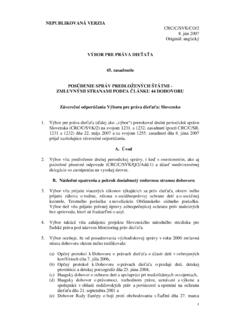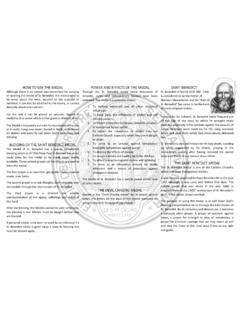Transcription of The Nature, Purpose, and Function of Criminal Law
1 11 The nature , purpose , and Function of Criminal LawMay the police officers be subjected to prosecution in both state and federal court?As the videotape begins, it shows that King rose from the ground and charged toward Officer Powell. Powell took a step and used his baton to strike King on the side of his head. King fell to the ground. From the eighteenth to the thirtieth second on the videotape, King attempted to rise, but Powell and Wind each struck him with their batons to prevent him from doing so. From the thirty-fifth to the fifty-first second, Powell admin-istered repeated blows to King s lower extremities; one of the blows fractured King s leg.
2 At the fifty-fifth second, Powell struck King on the chest, and King rolled over and lay prone. At that point, the officers stepped back and observed King for about 10 seconds.. At one-minute-five-seconds (1:05) on the vid-eotape, Briseno, in the District Court s words, stomped on King s upper back or neck. King s body writhed in response. At 1:07, Powell and Wind again began to strike King with a series of baton blows, and Wind kicked him in the upper thoracic or cer vical area six times until 1:26. At about 1:29, King put his hands behind his back and was Concepts and Summary StatementsIntroductionThe Criminal law is the foundation of the Criminal justice system.
3 The law defines the acts that may lead to an arrest, prosecution, and imprisonment. States punish a range of acts in their Criminal nature of Criminal LawCrime is conduct that, if shown to have taken place, will result in a formal and solemn pronouncement of moral condemnation by the and Civil LawThe civil law protects the individual rather than the public purpose of Criminal LawThe Criminal law prohibits conduct that causes or threatens the public interest; defines and warns people of the acts that are subject to Criminal punishment; distinguishes between serious and minor offenses.
4 And imposes punishment to protect society and to satisfy the demands for retribution, rehabilitation, and Principles of Criminal LawBasic principles essential for understanding the Criminal law include the concepts of Criminal acts, Criminal intent, the concurrence between acts and intent, causality, responsibility, and of CrimeA. Felonies are punishable by death or by imprisonment for more than a year. Other offenses are misdemeanors. Some states provide for minor offenses that do not result in imprisonment; these are referred to as violations or Mala in se crimes are inherently evil; mala prohibita crimes are not viewed as inherently Crimes also may be categorized by subject matter; examples are crimes against a person or of Criminal LawA.
5 There are a number of sources of Criminal law ranging from the common law to state and federal statutes to the and state The common law originated in the common customs and practices of the people of England and can be traced to the Norman conquest of England in 1066 This law was transported to the American American states in the nineteenth century began to adopt comprehensive Criminal codes. States today differ on whether they continue to recognize the common law in areas not addressed by state statutes. Most states no longer recognize the common law, and there are no federal common law States possess the broad authority to protect the health, safety, welfare, well-being, and tranquility of the In 1962.
6 The American Law Institute adopted the Model Penal Code to encourage and guide the uniform drafting and reform of state The Constitution assigns various powers to the federal government that form the foundation for the federal Criminal The and individual state constitutions establish limits and standards for the Criminal a deeper look at this topic, visit the study y Criminal Law2 IntroductionThe Criminal law is the foundation of the Criminal justice system. The law defines the conduct that may lead to an arrest by the police, trial before the courts, and incarceration in prison.
7 When we think about Criminal law, we typically focus on offenses such as rape, robbery, and murder. States, however, condemn a range of acts in their Criminal codes, some of which may surprise you. In Alabama, it is a Criminal offense to promote or engage in a wrestling match with a bear or to train a bear to fight in such a A Florida law states that it is unlawful to possess any ignited tobacco product in an Rhode Island declares that an individual shall be imprisoned for seven years who voluntarily engages in a duel with a dangerous weapon or who challenges an individual to a In Wyoming you can be arrested for skiing while being impaired by alcohol4 or for opening and failing to
8 Close a gate in a fence that crosses a private road or river. 5 You can find Criminal laws on the books in various states punishing activities such as playing dominos on Sunday, feeding an alcoholic beverage to a moose, cursing on a miniature golf course, making love in a car, or performing a wedding ceremony when either the bride or groom is In Louisiana, you risk being sentenced to ten years in prison for stealing an alligator, whether dead or alive, valued at $1, nature of Criminal LawAre there common characteristics of acts that are labeled as crimes?
9 How do we define a crime? The easy answer is that a crime is whatever the law declares to be a Criminal offense and punishes with a penalty. The difficulty with this approach is that not all Criminal convictions result in a fine or imprisonment. Rather than punishing a defendant, the judge may merely warn him or her not to repeat the Criminal act. Most commentators stress that the important feature of a crime is that it is an act that is officially condemned by the community and carries a sense of shame and humiliation.
10 Professor Henry M. Hart, Jr. defines crime as conduct which, if .. shown to have taken place will result in the formal and solemn pronouncement of the moral condemnation of the community. 8 The central point of Professor Hart s definition is that a crime is subject to formal condemna-tion by a judge and jury representing the people in a court of law. This distinguishes a crime from acts most people would find objectionable that typically are not subject to state prosecution and official punishment. We might, for instance, criticize someone who cheats on his or her spouse, but we generally leave the solution to the individuals involved.















